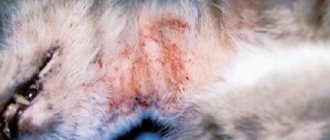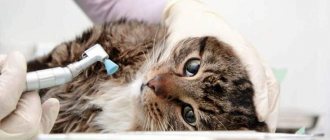Features of the course of the disease in children
In children, allergies to cats manifest themselves more often and more clearly. Children are especially susceptible to this during periods of weakened immunity (for example, when teething, during the transition from breastfeeding to regular feeding, when entering kindergarten, etc.). Sometimes allergy symptoms can appear even after one-time contact with a Sphynx. Main symptoms:
- severe runny nose and sneezing;
- dry debilitating cough, shortness of breath;
- temperature rise to 38 degrees;
- diarrhea, loss of appetite;
- swelling of the mucous membranes (throat, eyes, etc.);
- lymph nodes in the neck area become enlarged;
- redness on the skin (including at the site of contact with the cat).
Those owners of “hairless” cats who have infants in the house should be especially careful. Small children may stop breathing if they have shortness of breath, so at the first symptoms you need to contact your local pediatrician.
Parents of small children are advised to supervise their child's interaction with the cat.
Symptoms of a negative reaction
Allergies can manifest themselves:
Common symptoms of Sphynx allergy in adults and children:
- sore throat;
- frequent sneezing;
- rhinitis, dry cough;
- lacrimation, redness of the eyes;
- skin rashes, itching;
- swelling of the nasopharyngeal mucosa;
- bronchospasm;
- sometimes - enlarged lymph nodes.
Allergies are especially severe in children and pregnant women.
In infants, this type of allergy can lead to respiratory arrest. Along with allergic rhinitis and conjunctivitis, there are problems with the gastrointestinal tract. A newborn baby turns away from feeding, spits up, and shows anxiety.
With direct contact with the sphinx, the baby experiences redness and rashes on the face, neck, tummy, back, and buttocks.
Treatment of allergies to sphinxes
Animal care must be provided by a person who is not prone to allergic reactions
Before starting treatment, you need to accurately determine that the cause of the allergy is the Sphynx. For this purpose, a number of studies are carried out, including blood tests and allergy tests. And after the diagnosis is accurately established, the doctor prescribes treatment, which includes the following points:
- exclusion of contact with pets. And if you have a cat at home and suddenly an allergy appears, then you will have to give up your pet;
- taking antihistamines;
- hormonal agents;
- preparations for external use: ointments, gels, drops;
- If Quincke's edema develops, hospitalization will be required.
The occurrence of an allergic reaction to a pet is not just an unpleasant disease, but a real tragedy, because it means only one thing - you will have to say goodbye to your friend. But this is not always the only way out and it is quite possible to keep the cat if you adhere to the following rules:
- the Sphynx needs to be bathed at least 3 times a week, using special cosmetics that allow you to carefully rid the animal’s skin of dead skin particles;
- you will need to get a powerful vacuum cleaner that can easily clean any surface;
- Clothes and bedding should be washed as often as possible, stored in sealed bags and kept away from the cat;
- furniture upholstery should be leather, as it is easier to clean;
- the animal must be cared for by a person who is not prone to allergic reactions;
- The cat should not be in the same room as the allergic person;
- it is necessary to regularly carry out wet cleaning and ventilation of the room;
- All carpeting in the house must be removed, since a large amount of dead epidermis accumulates on it.
Treatment of the disease
In fact, the treatment is carried out in a classical way. The doctor refers the patient for diagnostics, makes a diagnosis and prescribes the necessary medications. You should start not by taking medications, but by eliminating the main irritant. It is quite possible that by ceasing contact with your pet, a person will completely get rid of allergies. If this helps, then you shouldn’t neglect your health and it’s best to say goodbye to your cat. There are several opinions that have not been scientifically proven, however, patients claim that they have an effect:
- cats cause allergies much less frequently than cats;
- perhaps if the cat is castrated, the allergy will go away;
- Blonde cats are less allergenic than dark cats.
In the event that the disease has already become acute, serious medical intervention in the form of taking medications will be required. At the first stage of treatment, the doctor prescribes antihistamines, which neutralize the effect of histamine and thereby relieve the patient of most of the unpleasant symptoms. This treatment does not provide a lasting therapeutic effect and is suitable for those patients whose disease is mild. The products are available both in tablet form and in the form of sprays, drops, and ointments. That is, the drugs can be used internally and topically. For patients with exacerbation, hormonal drugs and immunotherapy are suitable. Hormone-based products can only be used as prescribed by a doctor, since prolonged and arbitrary use of such drugs can lead to unpleasant consequences. If the patient experiences angioedema or anaphylaxis, you should immediately call an ambulance. If the patient is not given adrenaline or prednisone in a timely manner, he may die.
Possible types of allergies
Dermatitis
Most often, young individuals, up to 3 years old, are prone to such allergies. Typically, allergies can be caused by a hygiene substance, pollen or mold.
This category also includes an esinophilic plaque, which appears on the stomach in the form of an oval spot and is a consequence of allergies.
Parasite bites
Don’t think that if a Sphynx doesn’t have fur, then it doesn’t have fleas. Parasites can live in the armpits and in the shells of the ears. When in contact with other animals, fleas can jump onto the Sphynx and bite it. Such an allergy is dangerous because the owners do not believe that the cat can be bitten by fleas, and as a result they do not get rid of the parasites.
Food allergies
As a rule, it does not appear immediately, since allergens first accumulate in the body and only then act. Repeated allergies are dangerous, which can appear instantly and practically kill the animal. Most often, allergies are caused by food produced by dishonest manufacturers. Ordinary protein, including dairy products, can also cause allergies.
Flower allergy
Like all other cat breeds, Sphynx cats love to taste house flowers, but this is a dangerous addiction that can lead not only to allergies, but also to death. Sphynxes do not tolerate pollen from lilies well, and azalea can generally kill a cat. Beautiful Dieffenbachia can burn mucous membranes. Gartensia causes intoxication and allergies.
Clinical picture of the disease
Symptoms of allergies to hairless cats vary widely. As the body fights the allergen, a person begins to experience the following negative reactions:
- Sneezing appears, as well as swelling of the nasal mucosa.
- Severe dry cough.
- Swelling of the airways, as well as bronchospasms.
- Allergic rashes in the form of urticaria or dermatitis, which is accompanied by severe itching.
Many people still don’t believe that hairless cats can cause severe allergic reactions.,
so they are interested in whether there is an allergy to sphinxes? After all, it is believed that because sphinxes are hairless, they are less allergenic. But in fact, any cat is potentially dangerous; in any case, it can cause illness. And in this case this does not depend in any way on the breed, length of coat or shedding. A person who decides to get a pet such as a cat is still potentially exposed to diseases such as allergies. So, for people suffering from allergies, the idea of having a pet is not a good one.
If you are planning to get a Sphynx, then remember that an allergy to the Sphynx will also not be excluded.
How to check if you are allergic to the Sphynx?
Very simple. You need to be in contact with the cat for some time (half an hour - an hour) and if it is there, it will definitely appear. This can be either ordinary sneezing with an itchy nose, or a rash over the body, swelling of the upper respiratory tract.
How to minimize risks?
No one can guarantee that you or any family member will never be allergic to cats. It can also occur after a long time of living together with an animal.
If your body is sensitive to the effects of various types of allergens, it will be useful to know a few tips:
It's better to choose a cat than a male cat.
Cats are generally less likely to cause allergic reactions than cats.
Bathe the animal once every 2-3 days. This procedure will wash away skin secretions, that is, allergens.
It is preferable that the house have a minimum of upholstered furniture and carpeting, which, like a sponge, accumulate everything that flies around. This rule is true for any allergy sufferer.
What to do if an allergy to Sphynx cats occurs unexpectedly?
As already mentioned, allergies may not occur immediately, but after a while. If there was already a Sphynx in the family and someone in the family is allergic to it, you need to:
Make sure that the allergic reaction occurs specifically to the animal. This can be noticed by exacerbations of allergy attacks after close contact with an animal.
And if this is the case, there may be several options:
1. Contact an allergist, entrust the care of the Sphynx to someone else, bathe it regularly, carry out wet cleaning in the house more often, do not let the cat into certain rooms (for example, the bedroom) where you can be calm.
Very often, these measures are quite enough for a successful common life with the sphinx.
2. Give the cat into the good hands of friends or acquaintances. It's sad, but sometimes this is a necessary measure.
I've had my Sphynx for a year now. I don’t know if I’m allergic to it or not. Because when I go to visit friends and they have a cat, I don’t notice anything. My nose itches but periodically, my eyes sometimes water. I took general blood tests, there is an increased allergen, the norm is 5, and mine is 5.7. I don't know if it's a cat or not. I went to visit others who don’t have animals, and my eyes started to swell. Tell me what to do?
You need to donate blood for the cat allergen, saliva and epithelium. It will definitely be clear there
Peculiarities
Allergies to sphinxes appear more often than to other pets. This is due to frequent protein production. These animals can cause an allergic reaction even in those people who do not suffer from this disease. After all, cats bring dust and pollen into the house.
The phenomenon is considered widespread. This is often associated with increased sweating. These cats are clean, they lick themselves, which is why they produce a lot of saliva. It contains a protein that provokes this phenomenon. Some species of this breed are more likely to cause adverse reactions. These include Canadians. It is a beautiful animal, but not entirely unsafe.
An allergy to the Sphynx cat occurs in people who have a tendency to have inappropriate reactions in the body. The cost of such animals is quite high, so you need to ask the seller about the possibility of returning the pet.
Allergies to the Don Sphynx are common. To check for its presence, you need to stay in the same room with your pet for 1 hour. If there is any reaction, the kitten must be returned. Moreover, an allergy may appear not necessarily to the cat, but to other irritants.
Adverse reactions appear due to dust and other provocateurs of the disease. If any negative factors are detected, you should consult a doctor. It is necessary to undergo an examination to find out the cause of the problem.
How to treat a hypersensitivity attack?
First of all, take the cat away from the allergic person, send him to the bath to wash and rinse his mouth. If the attack is severe, then you need to give antihistamines such as Diazolin, Zyrtec, Cetirizine, Loratadine or the like.
If swelling of the respiratory tract appears, which makes it difficult for an allergic person to breathe, then you need to call doctors to prevent a shock anaphylactic state.
If you have just decided to buy a Sphynx and want to protect yourself from allergic attacks, then follow the recommendations listed below:
- Choose cats that are light in color. Scientists have found that they are less dangerous for hypersensitive people than dark ones.
- In the rooms where the animal is located, be sure to install humidifiers and air ionizers. The better the quality of indoor air, the less likely allergies are.
- It is not recommended for a hypersensitive family member to have frequent or long-term contact with the cat. If this is a child who finds it difficult to explain why his beloved cat should not be touched, then invite him to play with the pet remotely using toys. For example, you can use a stick with a ribbon. So the child will not have fun with his pet without touching him.
- It is difficult to train a cat not to climb on beds and sofas. Therefore, it is better to purchase special covers for mattresses and pillows. They allow air to pass through and protect textiles from dust, wool, pollutants and microparticles.
- When choosing a Sphynx, give preference to a cat, since cats provoke hypersensitivity much more often.
Author of the article: Elena Smirnova (dermatologist)
Diagnosis of the disease
Symptoms: rash
Determining whether there is a disease or not is quite simple. To do this, you should spend some time separately with your cat. If the symptoms disappear, then the cause of the disease lies precisely in the pet. The only option in this case that can be recommended to a person is to transfer the animal into safe hands. It is pointless to treat a disease in which there is constant contact with the allergen. Of course, this method of determining the disease is not the only one, and the allergist usually prescribes special laboratory tests that can confirm whether the disease is present or not. This is necessary so that the doctor can prescribe the correct course of treatment. If the diagnosis is not made accurately, then it is quite possible that the patient will experience complications, which are even more difficult to cope with than the disease itself.
Which cats are suitable for allergy sufferers?
Unfortunately, the absence of fur in an animal does not provide any guarantee that the health of an allergic person will be safe. Bare skin is more exposed to the environment and renews itself faster, which means more skin particles are released into the air.
There are people who are allergic to hairless cats and calmly communicate with furry ones. The only way to identify a cat breed that does not cause allergies is through experimentation. It is enough to be close to an animal for a couple of hours to understand how your body reacts to it. The mechanism of allergy occurrence is complex and difficult to predict. Sometimes two cats of the same breed, gender and age affect an allergic person differently.
It has been noted that allergy sufferers react least frequently to the following cat breeds:
- Siberian;
- Neva Masquerade;
- Balinese;
- Javanese;
- oriental;
- Devon Rex and Cornish Rex;
- sphinx.
Surprisingly, this list included some types of cats with thick and long hair! It is especially worth highlighting Siberian cats. It turns out that the Fel D1 protein, to which most allergy sufferers are sensitive, was not found in their saliva. However, the manifestations of allergies are individual and unpredictable, so you will have to “try” all the breeds from the above list on yourself.
Most allergy sufferers opt for cats without fur. Such cats, unlike their furry counterparts, are easier to wash, and weekly washing of the cat significantly reduces its allergenicity. In addition, carpets and furniture will not become breeding grounds for hair that is dangerous to your body. Are there allergies to hairless cats? Let's take a closer look at hairless cat breeds and consider how harmless each of them is for allergy sufferers.
Petersburg Sphinx
Peterbalds or St. Petersburg sphinxes delight the eye with their slenderness and grace. There are four types of St. Petersburg Sphynx kittens: naked (with absolutely smooth skin), velor (with small hairs), brush (with short hair) and straight-haired (such kittens are no longer quite Sphynxes and do not participate in further breeding). For allergy sufferers, naked or velor kittens are recommended.
By nature they are very playful and dynamic, not suitable for lovers of quiet and phlegmatic cats. Despite all their activity, they are not prone to hooliganism and are very smart, so they can avoid stripped wallpaper and sofas. Extroverts will appreciate the sociability of Peterbalds.
St. Petersburg Sphynxes are distinguished by their easy-going and easy-going disposition, and get along well with other pets and children. They are not picky about food, but it is better to use premium food.
The St. Petersburg Sphynx can “sweat”, or rather, secrete a special skin lubricant and leave dirty spots wherever it lies. It will have to be washed at least once every two weeks. Unlike many of their long-haired counterparts, Sphynx cats have a positive attitude towards water and even splash in the bath.
Many allergy sufferers get along well with Peterbalds, but you should not trust the breeder if he promises that the cat will definitely not be allergic. Be sure to spend a few hours in the company of your Peterbald before deciding to take him home.
Don Sphynx
The Don Sphynx is a medium-sized animal with a strong build and graceful paws. The face features cheekbones and eyebrows, almond-shaped eyes, and a curled mustache. Unlike its Russian counterpart, the St. Petersburg Sphynx, the Don Sphynx has a calmer temperament. These cats are kind, lazy, conflict-free, and sleep a lot. They rarely scratch or bite, readily show love to people, and have a more muscular body than the Peterbald.
Don Sphynxes are especially heat-loving and eat more than other breeds of hairless cats. This is due to large energy losses for heating the body.
Kittens of this breed can be naked, velor or brushed
Please note that the hairlessness of these cats may be temporary. Due to changes in hormonal levels or seasons, Don Sphynxes may acquire a small coat of fur or, conversely, lose it.
It's hard not to be charmed by the Don Sphynx's friendliness, but its secretions can be allergenic for some people.
Dermatitis in sphinxes: causes, treatment, prevention. How to treat allergies in sphinxes
- Sores on the skin (they can vary from light pink to almost black).
- Pimples in the armpits and groin area.
- Itching, external restlessness of the cat.
- A burning sensation that leads to severe scratching of wounds on the cat’s body.
- Runny nose, redness and watery eyes.
Naturally, only a veterinarian can prescribe competent treatment. Therefore, at the first signs of illness, you need to urgently take your pet for testing.
Remember, itching and burning can be caused not only by allergies, but also by subcutaneous mites.
This is a completely different story, and accordingly, the treatment is also different.
If your cat is diagnosed with allergies, try to switch him to natural food. More rice, fresh lamb or lamb. This will boost your pet’s immunity and help him get rid of the unpleasant disease as soon as possible.
How to treat allergies in a Sphynx?
It is important to identify the true source of the allergy, to facilitate the complete elimination and removal of harmful toxic substances from the body. Treatment of allergies to the Sphynx is complex:
- sorbents;
- antiallergenic drugs;
- glucocorticosteroids (Nasonex, Beclomethasone);
- antihistamines to quickly block histamine receptors.
IMPORTANT! You should not take allergy medications without consulting your doctor. Incorrect treatment at home is fraught with many exacerbations and complications of the underlying disease
It is possible to use traditional medicine methods: decoctions, lotions from medicinal herbs for skin rashes, in particular in children.
It is necessary to strengthen the care of pets
It is important to prevent anaphylactic shock and try to get rid of the problem in a matter of days
Antihistamines
If a sudden allergic reaction occurs (lacrimation, sneezing, nasal congestion), antihistamines (Cetrin, Diazolin, Loratidine, Erius) will provide emergency assistance. At the pharmacy you can buy syrup and drops for children - Fenistil.
REFERENCE! You should not prescribe antihistamines to yourself, without a doctor’s instructions. Side effects may occur (diarrhea, fever, high temperature, dry mouth).
Immune-specific treatment
The essence of therapy is the introduction under the skin of an allergen that has caused excessive susceptibility in a person. This is an allergen vaccine aimed at hyposensitization, reducing sensitivity to the introduced allergen.
Unfortunately, it affects only one of the links in pathogenesis, suppresses the unpleasant symptoms of allergic reactions, but is unable to eliminate the provoking factors in full. The time interval for the effectiveness of the course of immunotherapy is up to 4 years.
Further, allergy symptoms in hypersensitive patients may resume again.
Unfortunately, it is impossible to completely eradicate possible allergy attacks.
It is important to review your diet, eliminate harmful irritating foods and include more vitamins and minerals to strengthen the immune system. As for sphinxes, for whom food should be nourishing, healthy, balanced
The main thing is to prevent secondary manifestations of allergies, to prevent transition to the chronic stage with constant exacerbations. This is especially true for weakened people (children, elderly people, pregnant women) with an unstable immune system.
Prevention
Many animal lovers would like to have such an exotic pet as a Sphynx.
But before doing this, it is necessary to determine whether dangerous symptoms of the disease will appear.
How to check if you are allergic to Sphynxes?
It's easy to do.
You should place the animal on the lap of a potential patient and observe its condition.
Allergy sufferers often wonder what breed of cat is right for them?
Unfortunately, if you have symptoms of the disease, you will have to completely abandon animals in your home.
The reason is that allergies are caused not even by fur, but by the protein contained in the skin, urine, saliva, and smell, and all animals, without exception, have them.
If a cat does appear in the house, the following is necessary:
Wash your Sphynx regularly, see how to do it correctly in the video below;
- Ventilate the room where your pet is located several times a day;
- carry out wet cleaning there daily;
- refuse carpets and fabric coverings on sofas, as they are difficult to clean and contain particles of animal skin;
- wash your hands after handling your cat;
- entrust her care to a family member who does not suffer from allergies;
- find new owners for the sphinx as quickly as possible.
Sphynx care
To avoid the risk of allergies, cats require careful care. Nature intended for hairless skin not to dry out. A brownish, waxy mixture is released from the pores. The lubricant is colorless, so it does not stain clothes, but it may have an odor. Your pet's skin will be sticky, which will collect dust and dirt.
To prevent the animal from changing its light color to black, they must be wiped with baby wipes. Every 2 weeks you need to rinse in water and clean your ears weekly using cotton swabs. The eyes of sphinxes are not protected by eyelashes, so they must be washed every day with warm water and wiped with a napkin. If necessary, antibacterial drops are used to protect against eye diseases.
It is necessary to trim the claws regularly. This will protect against snags on clothes and curtains, and will also eliminate the clicking noise on the floor. Special care must be taken for the animal's latrine. Most of them are litter trained from childhood. The owners only need to keep the pot clean and change it regularly.
Thus, an allergy to the Sphynx can occur in any child or adult. It is necessary to carry out treatment after the doctor has prescribed the drugs. Proper care of your pet and implementation of preventive measures will help prevent adverse events.
What to do if your Sphynx cat has a food allergy
Despite the fact that the Sphynx cat breed is already familiar to many, it has not become less exotic for people. There are three main types of sphinxes: Canadian, Don and St. Petersburg sphinxes. Depending on the species, animals react differently to allergen substances, which are divided into food and non-food. Next, we’ll look at food allergies that are common among Sphynx cats, their causes, symptoms and treatment.
Causes
Food allergic reactions can be caused by various factors:
- weakened immune system;
- content in food of dyes and additives that are not natural;
- use of antibiotics in treatment;
- the body's sensitivity to herbal medicines;
- the body's reaction to allergenic foods;
- a reaction to a glycoprotein or protein produced by the cat’s body (typical of Don Sphynxes);
- reaction to proteins or carbohydrates.
Main symptoms
The main symptoms include:
- skin itching;
- red rash;
- red spots of various shapes;
- digestive system disorder;
- ulcers on the skin, mucous membranes, oral cavity, accompanied by pain and itching;
- lesions on the abdomen and inner thighs in the form of oval red spots;
- yellowish-pink plaques on the body or in the mouth;
- dandruff;
- the animal scratches its ears and nose excessively;
- armpit moisture;
- changes in behavior: lethargy, drowsiness.
Diagnostics in a veterinary clinic
To accurately diagnose spots or rashes on the skin of an exotic animal, you need to take the cat to a veterinary clinic.
Before visiting a doctor, you need to prepare notes with the dates of the onset of painful signs and the nature of their manifestation, depending on changes in diet or medications.
This is important for determining the actual causes of the pet’s illness.
Food allergies in cats are difficult to determine and do not occur overnight: allergens need to accumulate in the body and only then begin to act. However, with repeated cases of allergies, the reaction will already be visible in a matter of minutes.
- Skin scraping to determine microbial flora.
- Blood test (if the rash is caused by an insect bite, the test will show this).
- Allergy tests (can determine what the allergy is to, but not the allergen itself: perhaps dust, medications, fleas, etc.).
- Prescription of special diagnostic nutrition for a period of up to 2 months to identify food allergens. This type of nutrition introduces completely new products for the animal. During this period, deviations are not allowed, even in the form of a small piece of a familiar delicacy, due to a possible error in diagnosis.
Treatment method and prognosis
If instrumental and laboratory tests do not confirm a food allergy, then the doctor’s prescription usually contains:
- antimicrobial treatment (to alleviate the pet’s condition);
- antihistamines;
- compliance with special diagnostic nutrition.
If a food allergen is identified, it is necessary to reconsider the Sphynx's diet.
Treatment of food allergies is a lengthy process that requires no relief. Compliance with the cat's nutritional requirements must be observed throughout the animal's life, avoiding the inclusion of an allergen in the diet.
What to do at home
According to the treatment and nutrition regimen prescribed by the doctor, it is necessary to begin restoring the pet’s health.
Noting the sensitivity of sphinxes to various drugs, as well as food compounds of proteins and carbohydrates, you need to carefully monitor your pet’s skin. If spots (rashes, ulcers, etc.) increase, you should immediately contact the clinic to adjust the course.
When taking medications, you should pay attention to the dosage depending on the age of the animal. Overdose is unacceptable
To eliminate the nervousness of the sphinx due to the lack of treats and the need to take medications, you should pay more attention to the animal, observe regular changes of drinking water and provide it with a warm sleeping place.
About the breed
Cats of this breed have hairless, delicate skin.
Their features are large ears and slanted eyes. Adults reach 30-40 cm in height and weigh up to 5 kg. In this case, the color of the pet may be different. Sphynxes come in white, black, chocolate, blue, and cream. In total, 3 types of breed have been bred: the Canadian Sphynx, the Don and St. Petersburg Sphynx. Each of them has its own differences. The Canadian breed has a small layer of fur that is similar to the fuzzy skin of a peach. Among the Don and St. Petersburg sphinxes there are “clean-shaven” and a little hairy.
The first reason for the appearance of an allergy to the Sphinx is still a weak immune system. The body reacts sharply to absolutely all harmful substances, in particular to those directly released by the sphinx. He perceives them as some kind of virus or bacteria and immediately begins to actively fight them.
In addition, the animal can additionally leave particles of all its biological traces, such as urine and saliva on various objects, and the person then comes into direct contact with them. The biological traces of cats contain pathological substances that trigger negative reactions in the body and provoke serious allergies.
Some animals of this breed may have a small amount of fur located on the face and tail, which provoke allergies.
That is why, if you have previously experienced a severe allergy to the fur of any animal, then before getting a Sphynx, you should first consult with a doctor about the safety of keeping it.
This saliva then spreads throughout the entire house and provokes the development of a very serious allergy, which leads to the most unpleasant consequences. Sphynxes emit a large number of allergens, which are contained in their saliva and on the skin, which is why such animals provoke the development of allergies much more often than cats covered with hair.











